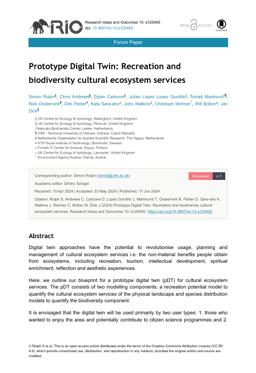2024-06-17
Prototype Digital Twin: Recreation and biodiversity cultural ecosystem services
Publication
Publication
Research Ideas and Outcomes , Volume 10 - Issue e125450
Digital twin approaches have the potential to revolutionise usage, planning and management of cultural ecosystem services i.e. the non-material benefits people obtain from ecosystems, including recreation, tourism, intellectual development, spiritual enrichment, reflection and aesthetic experiences. Here, we outline our blueprint for a prototype digital twin (pDT) for cultural ecosystem services. The pDT consists of two modelling components; a recreation potential model to quantify the cultural ecosystem services of the physical landscape and species distribution models to quantify the biodiversity component. It is envisaged that the digital twin will be used primarily by two user types: 1. those who wanted to enjoy the area and potentially contribute to citizen science programmes and 2. people who want to inform or make evidence-based management decisions (land managers, policy-makers, researchers).
| Additional Metadata | |
|---|---|
| , , , , | |
| doi.org/10.3897/rio.10.e125450 | |
| Research Ideas and Outcomes | |
| Released under the CC-BY 4.0 ("Attribution 4.0 International") License | |
| Organisation | Staff publications |
|
Rolph, Simon, Andrews, Chris, Carbone, Dylan, Lopez Gordillo, J., Martinovič, Tomáš, Oostervink, Nick, … Dick, Jan. (2024). Prototype Digital Twin: Recreation and biodiversity cultural ecosystem services. Research Ideas and Outcomes, 10(e125450). doi:10.3897/rio.10.e125450 |
|
